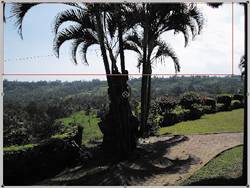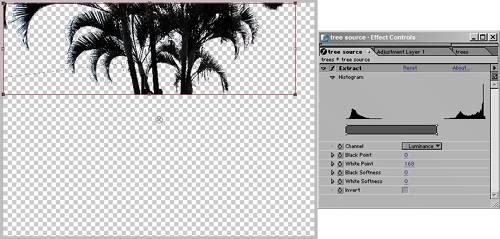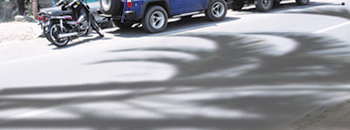Shadows and Reflected Light
| Uh-oh, I guess the time has come to talk about creating shadows. If lighting is complex, so are shadows, and maybe more so. At least with lights, if you know where they were placed in your source scene, you can gamely try to directly re-create those conditions. With shadows, however, you could have at your disposal the full dimensional information of the scene and all the lighting, but only a notion of how they should behave (although you have the advantage that your audience wouldn't know, either). Furthermore, because the world of After Effects is not fully three-dimensional, if you have to create realistic shadows from scratch, you're basically faking it. The addition of 3D features, including lights and shadow casting, to After Effects 5.0 improved the fakery potential, if only somewhat. The problem remains that you're still basically stuck using a flat 2D plane (or planes) to project a shadow and a flat plane (or planes) to receive it, and the greater the angle of difference between the camera and a given light, the less possible it is for that shadow to be accurate. Figure 12.30 illustrates the problem, using our old friend Sir Isaac lit from the left side with a spot. Keying to keep the shadow proved difficult. But re-creating it using the silhouette of the character is nearly impossible; clearly, his outline from the side bears almost no resemblance to his outline as seen by the camera. As you saw in Figure 12.6, there's not much possibility of changing his light direction here; it seems pretty evident that all of his lighting is coming from the left. Figure 12.30. Positioning a 3D light to the left of the character, where his appearance indicates it belongs, works even worse than you might expect. It yields a fake-looking shadow that includes details that shouldn't be there, such as the extended leg, and misses others that should be there, such as the outline of a head above two shouldersnot to mention how difficult it is to match the ground plane. Horrifying. Creating ShadowsFigure 12.31 shows the classic 2D solution for cast shadows, corner-pinning the matte to an angle that is something like that at which the camera sees the object, with a figure whose outline is complex and lit from an angle more than 10 or 15 degrees off axis from the camera. It doesn't work very well here, but it is certainly possible to pull it off with simpler objects. Figure 12.31. Sigh. Not much better is the corner pin approach, whereby a duplicate of the layer is made black and semi-opaque, then a Corner Pin effect is added to skew the layer as if it's lying down. This one would need a lot of hand-painting to get it right at all, and the angle in this case is completely wrong. Dismal.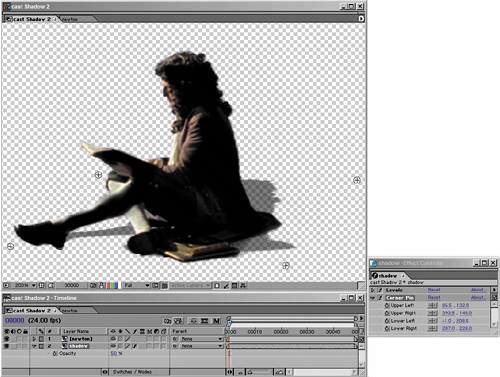 Another 2D trick is one borrowed from the games industry; The Orphanage was actually able to use this one extensively for the Level Four sequence of Spy Kids 3-D because the story of the movie was characters trapped inside a video game. The cheat is that characters only cast a small pool of shadow beneath their feet or where they're sitting, and so on. The simple way to create this one is to mask off part of the matted character and translate only that into position. By feathering the mask and blurring the matte contained inside it quite a lot, you add some subtle interactivity between the character and the ground plane and basically just hope nobody really thinks about it too much (Figure 12.32). Figure 12.32. Not much better, but almost acceptable if you dial it back to where it's almost imperceptible. The pool of shadow is created by masking the parts of the figure nearest the floor, offsetting and blurring them, then using the result as the alpha channel of an adjustment layer (or just sending it to black and semi-opaque and applying it directly). It's basically a hand-done variation on a drop shadow. Yeesh.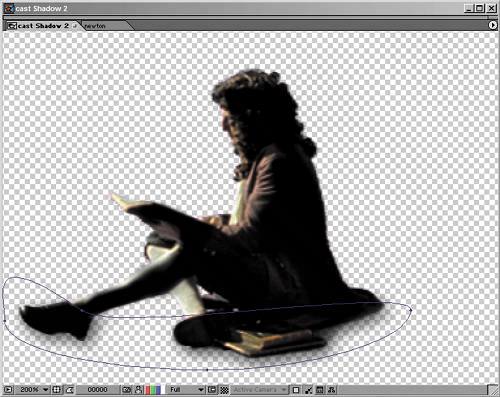
Overall, the Sir Isaac example has demonstrated that when there are shadows present on set, it would be preferable to do everything you can to try to bring them backeven rotoscope them and give them a key all their ownrather than submit to the humiliation of the desperate approaches outlined here. Or better yet, composite your character into an environmentsay, a grassy clearingin which the shadows would be mostly obscured. Reflected and Interactive LightIt's easy to forget the actual physics of what gives an object a certain color, probably because it's strange and even counterintuitive. The color of the surface is made up of the colors of light that it does not absorb. Most of what we see as light and color is the result of reflected light. Most surfaces in the natural world are diffuse, and the light that they reflect is sent out softly in all directions.
Thus in some subtle way, objects in a shot together light one another, and characters or objects that pass through a scene are relit to some degree as they change position. Two objects composited together are completely missing the light interactions that would be present between them had they been photographed together. Computer software is becoming better at re-creating these types of interactions. Global illumination and radiosity features have been added to 3D rendering programs in recent years to re-create the many effects of reflected light, enhancing the realism of completely synthesized scenes. For the compositor, however, this is still all more art than science, and the subjective evaluation of observed phenomena will in many cases go farther than the application of objective principles. In other words, the 3D artist can be more like a sculptor, letting the light play over the created work, but the compositor is still more like a painter, observing and artistically interpreting the world. Light that interacts directly with objects in your scene is something of an opportunity for you as a compositor. Nail down appropriate interactive lighting, and you infuse your scene with life and realism, helping to tell the story. |
EAN: 2147483647
Pages: 156

